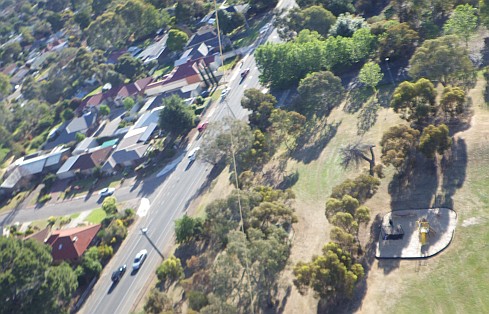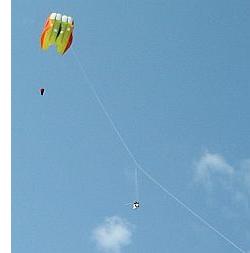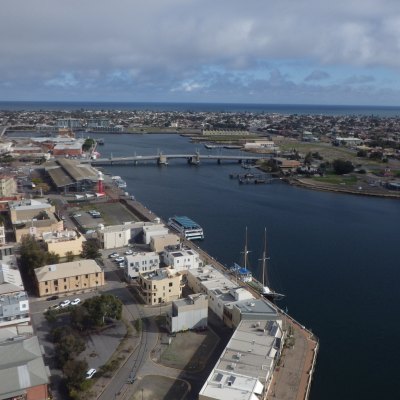- Home Page
- Aerial Photog.
Aerial Kite Photography
Nailing Your Camera to the Sky
Have you ever flown a kite or taken a photograph? Well, that's most of us isn't it! No wonder kite aerial photography (KAP) holds such a fascination for so many people.
 Picavet suspension
Picavet suspensionThese days, with relatively light digital cameras, it is becoming increasingly popular to take photos from kites as a hobby. Mind you, this trend might not continue forever, with the rise of cheap drones with built-in cameras.
At the cheapest end of the scale, disposable cameras combined with ice triggers and balsa wood cradles used to be used. This could be done under relatively small cheap kites. For example, you could make my Dowel Series dopero from hardwood and plastic sheet. This kite is "big" compared to some little sled or diamond you might buy for your 5-year-old kid to fly!
However, serious KAPers tend to use even larger kites, which can support the weight of more sophisticated photographic gear. Also there's the radio control (RC) gear to operate the camera while aloft!
Down below is one of my very early efforts, taken with a Pentax Optio camera that was firing off one shot every 10 seconds. The lifter kite was a 2.4 m (8 ft.) barn door.
Are you not so serious, but determined to have some fun getting aerial photos? A range of tiny and therefore light cameras are available online.
Some cameras have multi-shot options too.
KAP equipment at the cheap and simple end of the scale is within reach of just about anyone. However, some enthusiasts go to much more trouble and expense to get great pictures!
Some enthusiasts of aerial photography are after quality at any cost. Hence, they spend many hundreds of dollars on high-end cameras, radio-control gear, and special equipment to suspend it aloft with a minimum of movement. Why the RC gear? Well, the camera can be panned around to get the best shots and the shutter clicked on command. While these are the two main functions, there could be others like switching settings on the camera.
The photo above shows a typical KAP rig, hanging from the flying line of a large kite.
I was browsing around another KAP enthusiast's website the other day, and he made an interesting point about what draws people to the hobby.
He theorized that it's part of our human nature to want to see things from an aerial perspective. To support this idea, he mentioned the fact that aerial views of cities and landscapes were sketched or painted long before any flying machine was invented!
 Giddy perspective from a swinging KAP rig at 250 feet altitude
Giddy perspective from a swinging KAP rig at 250 feet altitudeThe hobby of aerial photography using kites got started in earnest around the mid-1980s. However, the very first examples of such photos date back to not long after photography itself was invented.
Before digital cameras became cheap, or even existed at all, keen KAPers would willingly hoist many hundreds of dollars worth of photographic gear up under their kites in order to take high-quality panoramic pictures.
Some Highlights
Here are just a few of the more notable activities of these photo-artistic kite flyers:
A quite famous aerial photograph was taken from a kite in 1906, documenting the San Francisco earthquake. A KAP enthusiast named Scott Haefner did a re-shoot of this striking picture, close to its 100th anniversary.
A small group of experts known as Team Drachen made good use of some grant money by using KAP to document whale behavior. This took place at San Ignacio Lagoon, Baja, in Mexico.
The appeal and intrigue of kite aerial photography was enough to entice Discovery Channel, Canada, to do a video clip on the hobby in January, 2004.
In November, 2002, a 360-degree panorama of the San Andreas fault was created from KAP images. Several other striking subjects got the 360 degree treatment as well.
Here's a just a few samples of some photos taken from kites.
Wind Speed Handy Reference
Light Air
1-5 kph
1-3 mph
1-3 knts
Beaufort 1
Light breeze
6–11 kph
4–7 mph
4–6 knts
Beaufort 2
Gentle ...
12–19 kph
8–12 mph
7–10 knts
Beaufort 3
Moderate ...
20–28 kph
13–18 mph
11–16 knts
Beaufort 4
Fresh ...
29–38 kph
19–24 mph
17–21 knts
Beaufort 5
Strong ...
39–49 kph
25–31 mph
22–27 knts
Beaufort 6
High Wind
50-61 kph
32-38 mph
28-33 knts
Beaufort 7
Gale
62-74 kph
39-46 mph
34-40 knts
Beaufort 8
Some History
Here are just a few interesting snippets from the past, giving you some idea of the origins and growth of the hobby.
Military Use
Just as the Cody kite and other early box kites were associated with military uses, so it was with aerial photography. In fact, advances in KAP techniques were a result of military use and experimentation for many years, starting in the late 1800s.
Arthur Batut
The first notable aerial kite photographer with no military connections was probably Arthur Batut, from France. He was passionate about photography and succeeded in developing a simple system to take photos from a large diamond kite, many hundreds of feet in the air. At this time, people had never seen images from an aerial viewpoint, so the pictures caused a sensation!
Believe it or not, Batut's pictures were made possible by advances in photographic technology! Even back in the late 1800s, photography had been around for 60 years or so. Weights and sizes had come down. Exposure times had decreased also.
A slow-burning fuse triggered the shutter release, after which a white flag dropped and the kite was reeled in. This was simple but effective.
The KAPWA Foundation
Now we skip forward to the 1980s. This is when KAP as we know it started to become widespread. An organization called KAPWA, a worldwide association of KAP enthusiasts, came into being. This organization, now known as the KAPWA Foundation, has organized events and made resources available to interested hobbyists since the 1980s.
In September 1987, the 75th anniversary of the International Competition of Scientific and Military Kites was celebrated. The competition was held in Belgium in 1912.
Between 1989 and 1993, KAPWA actively shared information and organized events with the Japanese Kite Aerial Photography Association.
Over the years, KAPWA has also been involved in more than 20 exhibitions of the finest aerial photography that could be found among its members. These exhibitions took place on just about every continent except Europe. That's interesting, since France is where it all started! International meetings specifically about kite aerial photography were also convened.



